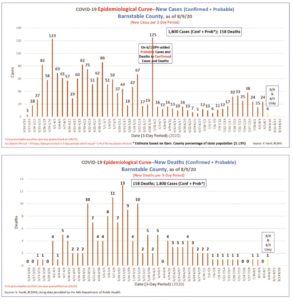PROVINCETOWN — Look closely, and Barnstable County’s graphs of new Covid cases and deaths tell a story. There’s an upward swell of discovered cases that begins a couple weeks after July 4, continues throughout the second half of July, and then starts to fall off again in August. It’s not a huge wave compared to what happened here in the spring, but it’s real.
The graph of deaths, thankfully, is scraping the bottom of the chart. As of Sunday, Aug. 9, there were no coronavirus patients being treated at Cape Cod Hospital or Falmouth Hospital — not just in intensive care units, but anywhere in either hospital. Hospitalization numbers have been very low while the July wave of cases was being identified.

There are two stories to tell here — one about what’s happening now, in July and August, and one about what happened in March, April, and May, when case and death numbers looked very different.
The July Wave
According to Sean O’Brien, the health and environment director for Barnstable County, many of the cases discovered in July and August have been people who are of working age who were infected at social gatherings. “The Chatham house party, as they’re calling it, and the Falmouth lifeguards party are, in fact, pretty significant drivers for this bump in cases we’ve discovered,” said O’Brien.
On Friday, Aug. 7, Gov. Charlie Baker reduced the limit for outdoor gatherings from 100 people to 50 and announced that police departments can enforce rules that had been previously assigned primarily to health departments. Provincetown had decided a month before, on July 2, to direct its police dept. to help manage the size of private gatherings.
“Our contact tracing teams have demonstrated that parties that are held in people’s homes and back yards have contributed to community spread and new Covid clusters,” said Gov. Baker. “These parties are too big, too crowded, and people are simply not being responsible — 40 or 50 people in somebody’s back yard.”
Meg Payne, the operations manager for the largest contact tracing effort in Barnstable County, said that both the Chatham and the Falmouth parties happened at specific residential addresses, although she didn’t know if they were indoors, outdoors, or both. “No one was wearing masks and maintaining social distancing at either party,” she added.
“There have been some events that, not surprisingly, have caused the governor to put some new restrictions in,” said O’Brien. “But in the same breath, we have zero Covid patients in each hospital today. I think, in a lot of ways, people are doing the right thing — staying outside, using hand sanitizer, social distancing, wearing a mask. In the long run, this seems to be working.”
The March-April-May Wave
Comparing the present data to the spring wave of cases leads to one enormous difference between then and now: nursing homes.
More than half of Cape Cod’s Covid casualties have been residents of just five nursing homes. Twenty-one residents died at Wingate in Harwich, 19 at Pleasant Bay of Brewster, 18 at Royal Cape Cod in Bourne, 17 at Cape Regency in Centerville, and 11 at South Dennis Healthcare Center. Another four nursing homes together account for 16 more casualties. These 102 deaths in nine facilities are 65 percent of Cape Cod’s total of 158 dead so far.
That means two-thirds of Cape Cod’s deaths have come from just nine locations.
Meanwhile, 11 nursing homes on Cape Cod reported zero deaths among residents from Covid. A close look at the numbers shows that in 17 out of 20 nursing homes, either no one died or a lot of people did.
“We had situations where Covid was going rampant, just ripping through some of these facilities,” said O’Brien. The damage was done early on. Nearly all these deaths had already transpired when information on deaths-per-facility was released by the state in late May.
Horrible as they are, these numbers are not at all unusual. According to the New York Times, in Massachusetts, 64 percent of deaths from Covid are linked to long-term care facilities. That number is 78 percent in Rhode Island, 74 percent in Connecticut, and 82 percent in New Hampshire.
The story of declining death rates is, in part, the story of nursing homes shutting themselves off from the world. In these facilities, phase one never really ended, and near-lockdown conditions are heading into their sixth month. “If you think about the mental health issues with that — the isolation, the families on the outside, what this does to communities,” said O’Brien. “After we get through this, I think you’re going to see changes nationwide to how we take care of our seniors.”
In the meantime, a look back at the graphs shows what hasn’t happened yet this summer. The virus hasn’t found its way back into densely housed populations where it can kill by the dozen — not just in nursing homes but in assisted living facilities, apartment complexes, firehouses, or the county jail. Connect the virus to those places, and a season of pretty good numbers could deteriorate into another season of bad ones.



